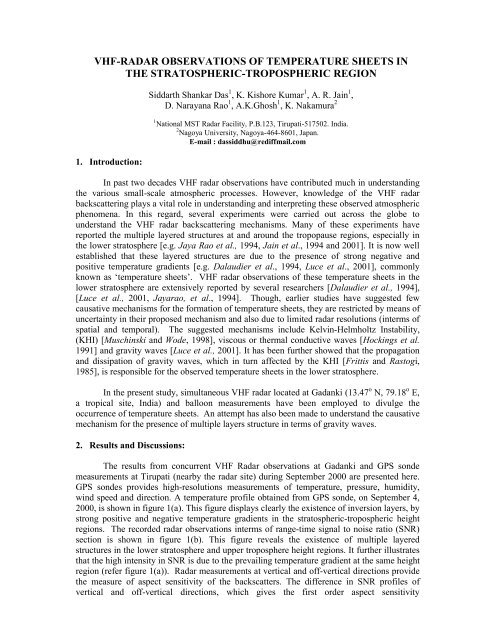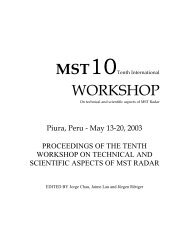vhf-radar observations of temperature sheets in the stratospheric ...
vhf-radar observations of temperature sheets in the stratospheric ...
vhf-radar observations of temperature sheets in the stratospheric ...
You also want an ePaper? Increase the reach of your titles
YUMPU automatically turns print PDFs into web optimized ePapers that Google loves.
VHF-RADAR OBSERVATIONS OF TEMPERATURE SHEETS INTHE STRATOSPHERIC-TROPOSPHERIC REGION1. Introduction:Siddarth Shankar Das 1 , K. Kishore Kumar 1 , A. R. Ja<strong>in</strong> 1 ,D. Narayana Rao 1 , A.K.Ghosh 1 , K. Nakamura 21 National MST Radar Facility, P.B.123, Tirupati-517502. India.2 Nagoya University, Nagoya-464-8601, Japan.E-mail : dassiddhu@rediffmail.comIn past two decades VHF <strong>radar</strong> <strong>observations</strong> have contributed much <strong>in</strong> understand<strong>in</strong>g<strong>the</strong> various small-scale atmospheric processes. However, knowledge <strong>of</strong> <strong>the</strong> VHF <strong>radar</strong>backscatter<strong>in</strong>g plays a vital role <strong>in</strong> understand<strong>in</strong>g and <strong>in</strong>terpret<strong>in</strong>g <strong>the</strong>se observed atmosphericphenomena. In this regard, several experiments were carried out across <strong>the</strong> globe tounderstand <strong>the</strong> VHF <strong>radar</strong> backscatter<strong>in</strong>g mechanisms. Many <strong>of</strong> <strong>the</strong>se experiments havereported <strong>the</strong> multiple layered structures at and around <strong>the</strong> tropopause regions, especially <strong>in</strong><strong>the</strong> lower stratosphere [e.g. Jaya Rao et al., 1994, Ja<strong>in</strong> et al., 1994 and 2001]. It is now wellestablished that <strong>the</strong>se layered structures are due to <strong>the</strong> presence <strong>of</strong> strong negative andpositive <strong>temperature</strong> gradients [e.g. Dalaudier et al., 1994, Luce et al., 2001], commonlyknown as ‘<strong>temperature</strong> <strong>sheets</strong>’. VHF <strong>radar</strong> <strong>observations</strong> <strong>of</strong> <strong>the</strong>se <strong>temperature</strong> <strong>sheets</strong> <strong>in</strong> <strong>the</strong>lower stratosphere are extensively reported by several researchers [Dalaudier et al., 1994],[Luce et al., 2001, Jayarao, et al., 1994]. Though, earlier studies have suggested fewcausative mechanisms for <strong>the</strong> formation <strong>of</strong> <strong>temperature</strong> <strong>sheets</strong>, <strong>the</strong>y are restricted by means <strong>of</strong>uncerta<strong>in</strong>ty <strong>in</strong> <strong>the</strong>ir proposed mechanism and also due to limited <strong>radar</strong> resolutions (<strong>in</strong>terms <strong>of</strong>spatial and temporal). The suggested mechanisms <strong>in</strong>clude Kelv<strong>in</strong>-Helmholtz Instability,(KHI) [Musch<strong>in</strong>ski and Wode, 1998], viscous or <strong>the</strong>rmal conductive waves [Hock<strong>in</strong>gs et al.1991] and gravity waves [Luce et al., 2001]. It has been fur<strong>the</strong>r showed that <strong>the</strong> propagationand dissipation <strong>of</strong> gravity waves, which <strong>in</strong> turn affected by <strong>the</strong> KHI [Frittis and Rastogi,1985], is responsible for <strong>the</strong> observed <strong>temperature</strong> <strong>sheets</strong> <strong>in</strong> <strong>the</strong> lower stratosphere.In <strong>the</strong> present study, simultaneous VHF <strong>radar</strong> located at Gadanki (13.47 o N, 79.18 o E,a tropical site, India) and balloon measurements have been employed to divulge <strong>the</strong>occurrence <strong>of</strong> <strong>temperature</strong> <strong>sheets</strong>. An attempt has also been made to understand <strong>the</strong> causativemechanism for <strong>the</strong> presence <strong>of</strong> multiple layers structure <strong>in</strong> terms <strong>of</strong> gravity waves.2. Results and Discussions:The results from concurrent VHF Radar <strong>observations</strong> at Gadanki and GPS sondemeasurements at Tirupati (nearby <strong>the</strong> <strong>radar</strong> site) dur<strong>in</strong>g September 2000 are presented here.GPS sondes provides high-resolutions measurements <strong>of</strong> <strong>temperature</strong>, pressure, humidity,w<strong>in</strong>d speed and direction. A <strong>temperature</strong> pr<strong>of</strong>ile obta<strong>in</strong>ed from GPS sonde, on September 4,2000, is shown <strong>in</strong> figure 1(a). This figure displays clearly <strong>the</strong> existence <strong>of</strong> <strong>in</strong>version layers, bystrong positive and negative <strong>temperature</strong> gradients <strong>in</strong> <strong>the</strong> <strong>stratospheric</strong>-tropospheric heightregions. The recorded <strong>radar</strong> <strong>observations</strong> <strong>in</strong>terms <strong>of</strong> range-time signal to noise ratio (SNR)section is shown <strong>in</strong> figure 1(b). This figure reveals <strong>the</strong> existence <strong>of</strong> multiple layeredstructures <strong>in</strong> <strong>the</strong> lower stratosphere and upper troposphere height regions. It fur<strong>the</strong>r illustratesthat <strong>the</strong> high <strong>in</strong>tensity <strong>in</strong> SNR is due to <strong>the</strong> prevail<strong>in</strong>g <strong>temperature</strong> gradient at <strong>the</strong> same heightregion (refer figure 1(a)). Radar measurements at vertical and <strong>of</strong>f-vertical directions provide<strong>the</strong> measure <strong>of</strong> aspect sensitivity <strong>of</strong> <strong>the</strong> backscatters. The difference <strong>in</strong> SNR pr<strong>of</strong>iles <strong>of</strong>vertical and <strong>of</strong>f-vertical directions, which gives <strong>the</strong> first order aspect sensitivity
measurements, is shown <strong>in</strong> figure 1(c). From this figure high aspect sensitivity can be noticedaround <strong>the</strong> <strong>temperature</strong> <strong>sheets</strong>, which <strong>in</strong> turn confirms <strong>the</strong> layered structure <strong>of</strong> <strong>the</strong>backscatters.In order to know <strong>the</strong> vertical wave length <strong>of</strong> <strong>temperature</strong> and SNR perturbations,wave analysis have been carried out and is shown <strong>in</strong> figure 2. As <strong>the</strong>re was no cont<strong>in</strong>uous<strong>radar</strong> <strong>observations</strong>, <strong>the</strong> wave anlysis is done <strong>in</strong> height doma<strong>in</strong> only to f<strong>in</strong>d out <strong>the</strong> verticalwavelenth <strong>of</strong> <strong>the</strong> observed perturbations. Both SNR and <strong>temperature</strong> show a peak <strong>in</strong>amplitude at <strong>the</strong> vertical wavelength <strong>of</strong> 1.6 km. This suggests that <strong>the</strong> modulation <strong>of</strong><strong>temperature</strong> is due to <strong>the</strong> propagation <strong>of</strong> atmospheric waves, which <strong>in</strong> turn reflects <strong>in</strong> <strong>the</strong>SNR <strong>observations</strong>. As mentioned earlier,due to <strong>the</strong> lack <strong>of</strong> cont<strong>in</strong>uous <strong>observations</strong> (both<strong>temperature</strong> and <strong>radar</strong> <strong>in</strong>tensity), wave periodicities are not estimated.Realiz<strong>in</strong>g <strong>the</strong> importance <strong>of</strong> <strong>the</strong>se studies a comprehensive campaign is carried out t<strong>of</strong>ur<strong>the</strong>r understand <strong>the</strong> existence <strong>of</strong> <strong>temperature</strong> <strong>sheets</strong>. Dur<strong>in</strong>g this campaign, we found asimilar k<strong>in</strong>d <strong>of</strong> structure as discussed above on September 25, 2002. On this day, cont<strong>in</strong>uous<strong>radar</strong> <strong>observations</strong> were taken for a period <strong>of</strong> 12 hours with time and height resolutions <strong>of</strong>7m<strong>in</strong> and 150 m respectively. The <strong>radar</strong> <strong>observations</strong> are also supported by <strong>the</strong> simultaneousGPS measurements at <strong>the</strong> <strong>radar</strong> site. Figure 3(a) shows <strong>the</strong> height pr<strong>of</strong>ile <strong>of</strong> <strong>temperature</strong>,which is reveal<strong>in</strong>g <strong>the</strong> prom<strong>in</strong>ent <strong>temperature</strong> structures <strong>in</strong> <strong>the</strong> lower stratosphere.September 4, 2000SNR (dB)(a) (b) (c)Figure 1. (a) Height pr<strong>of</strong>ile <strong>of</strong> <strong>temperature</strong> derived from GPS-Sonde measurements, (b)Height-Time-SNR section obta<strong>in</strong>ed from Gadanki VHF <strong>radar</strong> and (c) height pr<strong>of</strong>ile <strong>of</strong> SNRdifference between vertical and <strong>of</strong>f-vertical (10°) beam directions on September 4, 2000.September 4, 2000Figure 2. Vertical wave number spectra <strong>of</strong> <strong>temperature</strong> and SNR obta<strong>in</strong>ed on September 42000 (arrow <strong>in</strong>dicates <strong>the</strong> dom<strong>in</strong>ant wave number)
Cont<strong>in</strong>uous <strong>radar</strong> <strong>observations</strong> have been used to obta<strong>in</strong> <strong>the</strong> zonal, meridional andvertical velocities [Anandan et al., 1997]. The time series data <strong>of</strong> zonal, meridional andvertical velocity perturbations are fur<strong>the</strong>r subjected to Fourier analysis to get <strong>the</strong> powerspectra <strong>of</strong> <strong>the</strong> velocity perturbations. Figure 3 (b) shows <strong>the</strong> power spectra <strong>of</strong> zonal w<strong>in</strong>dperturbations on September 25, 2002. From this figure it can be noticed that <strong>the</strong> oscillationwith a time period <strong>of</strong> ~82.4 m<strong>in</strong> is dom<strong>in</strong>ant at most <strong>of</strong> <strong>the</strong> heights, especially <strong>in</strong> <strong>the</strong> lowerstratosphere. Moreover, it shows peak amplitudes <strong>in</strong> <strong>the</strong> lower stratosphere. But, it has beenobserved that <strong>the</strong> wave amplitudes are relatively weaker <strong>in</strong> <strong>the</strong> meridional and verticalvelocities (figures are not shown). The direction <strong>of</strong> horizontal propagation <strong>of</strong> gravity waves <strong>in</strong><strong>the</strong> troposphere are uniform <strong>in</strong> all directions whereas it will be eastward <strong>in</strong> <strong>the</strong> lowerstratosphere. This may be <strong>the</strong> reason for observed enhancement <strong>in</strong> <strong>the</strong> zonal w<strong>in</strong>dperturbations <strong>in</strong> <strong>the</strong> lower stratosphere [Tsuda et al., 1994].Generally, <strong>the</strong> gravity waves transport energy and momentum from lower atmosphereto middle atmosphere. Often, <strong>the</strong>se waves break wherever it encounters <strong>the</strong> dynamic andconvective <strong>in</strong>stabilities. When <strong>the</strong>se waves break <strong>the</strong>y deposit <strong>the</strong> momentum and energy <strong>in</strong>that region, which are very crucial for understand<strong>in</strong>g <strong>the</strong> wave <strong>in</strong>teraction with <strong>the</strong> large-scaleenvironment. In <strong>the</strong> present study <strong>the</strong> <strong>temperature</strong> and w<strong>in</strong>d field <strong>observations</strong> clearly shows<strong>the</strong> modulation <strong>of</strong> respective fields by <strong>the</strong> gravity waves. A thorough study is underway toreveal <strong>the</strong> gravity wave break<strong>in</strong>g and <strong>the</strong>ir consequences <strong>in</strong> <strong>the</strong> lower stratosphere.(a)Figure 3. (a) Height pr<strong>of</strong>ile <strong>of</strong> <strong>temperature</strong> derived from GPS-sonde measurement and (b)<strong>the</strong> spectra at different height levels for zonal w<strong>in</strong>d perturbations on September 25, 2002which shows <strong>the</strong> dom<strong>in</strong>ant time period <strong>of</strong> 82.4 m<strong>in</strong> (period =412/5) correspond<strong>in</strong>g to 5 thharmonic number. The total period <strong>of</strong> <strong>observations</strong> corresponds to ~412 m<strong>in</strong>.3. Conclud<strong>in</strong>g remarks:The existence <strong>of</strong> layered structures <strong>in</strong> <strong>the</strong> <strong>stratospheric</strong>-tropospheric height regionus<strong>in</strong>g VHF <strong>radar</strong> <strong>observations</strong> are presented <strong>in</strong> this paper. The enhanced <strong>radar</strong> reflectivitylayers associated with high aspect sensitivity are observed <strong>in</strong> <strong>the</strong> same height region, whichare attributed to <strong>the</strong> presence <strong>of</strong> <strong>temperature</strong> gradients. The spectral analysis revealed <strong>the</strong>vertical wavelength <strong>of</strong> ~1.6 km <strong>in</strong>dicat<strong>in</strong>g <strong>the</strong> perturbation <strong>of</strong> <strong>temperature</strong> by <strong>the</strong> propagat<strong>in</strong>ggravity waves. For <strong>the</strong> same k<strong>in</strong>d <strong>of</strong> structure, on <strong>the</strong> o<strong>the</strong>r day, <strong>the</strong> periodicity <strong>of</strong> <strong>the</strong>propagat<strong>in</strong>g waves is found to be 82.4 m<strong>in</strong>. These wave oscillations are more prom<strong>in</strong>entlyseen <strong>in</strong> <strong>the</strong> zonal w<strong>in</strong>ds, which have shown <strong>the</strong> peak amplitudes <strong>in</strong> <strong>the</strong> lower stratosphere.(b)
The present <strong>observations</strong> thus emphasize <strong>the</strong> gravity waves as an important source for <strong>the</strong>observed <strong>temperature</strong> <strong>sheets</strong> <strong>in</strong> <strong>the</strong> lower stratosphere. However, fur<strong>the</strong>r <strong>observations</strong> andevidences are required to shed more light on to this aspect.Acknowledgement:The authorities <strong>of</strong> Hydrospheric-Atmospheric Research Center, Nagoya University,Nagoya, Japan and S. V. University, Tirupati, India are acknowledge for <strong>the</strong>ir cooperation forlaunch<strong>in</strong>g GPS sondes from Tirupati, India dur<strong>in</strong>g September 2000. We are also thankful toPr<strong>of</strong>. G.S. Bhatt (Indian <strong>in</strong>stitute <strong>of</strong> Sciences, Bangalore) for his support <strong>in</strong> conduct<strong>in</strong>g <strong>the</strong>GPS sonde campaign from NMRF, Gadanki dur<strong>in</strong>g September-October 2002. One <strong>of</strong> <strong>the</strong>authors, SSD, is thankful to Indian Space Research Organisation (ISRO) for prov<strong>in</strong>g <strong>the</strong>fellowship and facility dur<strong>in</strong>g <strong>the</strong> study.References:Anandan, V.K., P. Balmuralidhar, P.B. Rao and A. R. Ja<strong>in</strong>, A method for adaptive momentsestimation technique applied to MST <strong>radar</strong> echoes, Progress <strong>in</strong> electromagnetic researchsymposium, Telecommunication research center, City University <strong>of</strong> Hongkong, Vol.2,pp. 670, 1997.Dalaudier, Francis, Claude Sidi, Michel Crochet and Jean Vern<strong>in</strong>, Direct Evidence <strong>of</strong>“Sheets” <strong>in</strong> <strong>the</strong> Atmosphere Temperature Field, J. Atmos. Sciences, 51, 237, 1994.Fritts,D.C. and P.K.Rastogi, Convection and dynamical <strong>in</strong>stabilities due to gravity wavesmotions <strong>in</strong> <strong>the</strong> lower and middle atmosphere : <strong>the</strong>ory and <strong>observations</strong>, Radio Sci.,20,1247-1277, 1985.Hock<strong>in</strong>g, W.K., Fukao, S., M.Yamamoto., T. Tsuda and S. Kato., Viscosity waves and<strong>the</strong>rmal-conduction waves as a cause <strong>of</strong> “specular” reflectors <strong>in</strong> <strong>radar</strong> studies <strong>of</strong> <strong>the</strong>atmosphere, Radio Sci., 26, 1281-1303, 1991.Ja<strong>in</strong>, A.R., Jaya Rao Y., P.B.Rao., G. Viswanathan., S.H.Damle., P. Balamuralidharan andAnil Kulakarni, Prelim<strong>in</strong>ary <strong>observations</strong> us<strong>in</strong>g ST mode <strong>of</strong> Indian MST Radar :Detection <strong>of</strong> <strong>the</strong> signature <strong>of</strong> Tropopause, J. Atoms. and Terr. Phy, 56, 1157-1162, 1994.Ja<strong>in</strong>. A.R., Y.Jaya Rao, and N.S. Mydhili, Height-time-structure <strong>of</strong> VHF backscatter fromstable and turbulently mixed atmosphere layers at tropical latitudes, J.Atmos. Solar-Terr.Phys., 63,1455-1463, 2001.Jayarao, Y., A.R.Ja<strong>in</strong>., V.K.Anandan., P.B.Rao., G.Viswanathan and R. Arav<strong>in</strong>dan, Some<strong>observations</strong> <strong>of</strong> tropical tropopause us<strong>in</strong>g ST mode <strong>of</strong> <strong>the</strong> Indian MST <strong>radar</strong> : Multiplestable layer structure, Indian J Radio and Space Phy, 23, 75-85, 1994.Luce, H., M.Crochet and F. Dalaudier, Temperature <strong>sheets</strong> and aspect sensitive <strong>radar</strong> echoes,Annales Geophysicae, 19, 899-920, 2001.Musch<strong>in</strong>ski Andreas and Wode Christian., First In situ evidence for Coexist<strong>in</strong>g Submeter<strong>temperature</strong> and humidity Sheets <strong>in</strong> <strong>the</strong> Lower free Troposphere., J. Atmos. Sciences., 55,2893-2906, 1998.Tsuda Toshitaka, Yasuhiro Murayama, Harsono Wiryosumarto., Radiosonde <strong>observations</strong> <strong>of</strong>equatorial atmosphere dynamics over Indonesia. 2. Characteristics <strong>of</strong> gravity waves., J.Geophy. Res, 99, 10507-10516, 1994.
















